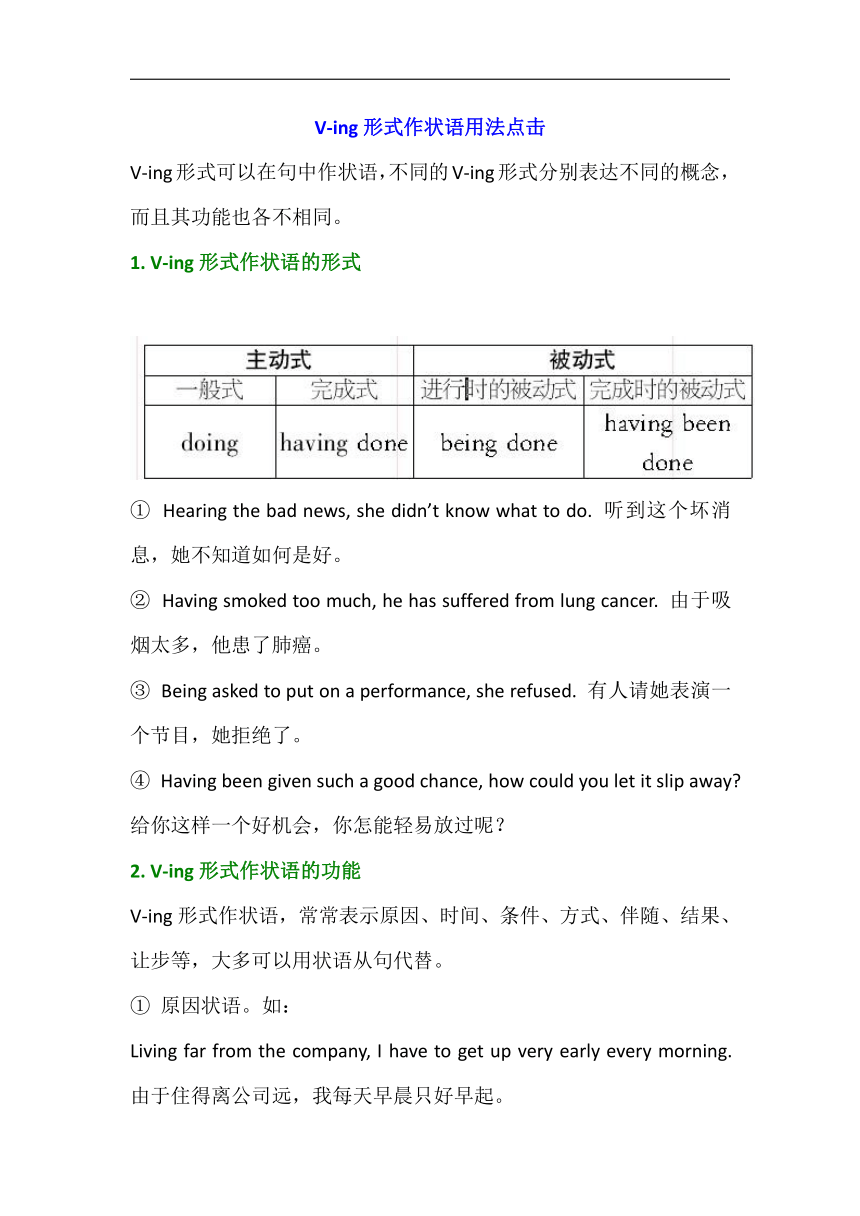人教新课标英语必修四 Unit4 Body anguage V-ing形式作状语用法点击教案
文档属性
| 名称 | 人教新课标英语必修四 Unit4 Body anguage V-ing形式作状语用法点击教案 |  | |
| 格式 | zip | ||
| 文件大小 | 32.1KB | ||
| 资源类型 | 教案 | ||
| 版本资源 | 人教版(新课程标准) | ||
| 科目 | 英语 | ||
| 更新时间 | 2019-09-06 09:59:35 | ||
图片预览

文档简介
V-ing形式作状语用法点击
V-ing形式可以在句中作状语,不同的V-ing形式分别表达不同的概念,而且其功能也各不相同。
1. V-ing形式作状语的形式
① Hearing the bad news, she didn’t know what to do. 听到这个坏消息,她不知道如何是好。
② Having smoked too much, he has suffered from lung cancer. 由于吸烟太多,他患了肺癌。
③ Being asked to put on a performance, she refused. 有人请她表演一个节目,她拒绝了。
④ Having been given such a good chance, how could you let it slip away? 给你这样一个好机会,你怎能轻易放过呢?
2. V-ing形式作状语的功能
V-ing形式作状语,常常表示原因、时间、条件、方式、伴随、结果、让步等,大多可以用状语从句代替。
① 原因状语。如:
Living far from the company, I have to get up very early every morning. 由于住得离公司远,我每天早晨只好早起。
② 时间状语。如:
Opening the door, I found nobody in. 打开门的时候,我发现里面没有人。
③ 条件状语。如:
Working hard at your lessons, you are to succeed. 努力学习,你就一定会成功。
④ 方式、伴随状语。如:
They came running all the way. 他们一路跑着来的。
⑤ 结果状语。如:
The fire lasted nearly 3 hours, leaving nothing valuable. 大火持续了将近3个小时,几乎没剩下什么有用的东西。
注意:V-ing形式作结果状语,表示一种必然的结果;而动词不定式则往往表示出乎意料之外的结果。如:
He woke up in the morning, only to find it was too late for school. 他早晨醒来,结果发现上学时间太晚了。
3. V-ing形式作状语须注意的问题
① 逻辑主语
V-ing形式作状语,其逻辑主语一般就是句子的主语,它们之间是一种逻辑上的主谓关系。如:
Being ill, he didn’t attend the meeting. 因为生病,他没有出席会议。
② 独立主格
V-ing形式作状语,有时它也可以有自己独立的主语,这种结构被称为独立主格结构,通常用来表示伴随的动作或情况,也可以表示时间、原因或条件。如:
The rain having stopped, we went on marching. 雨过之后,我们继续前进。
③ 评论性状语 / 悬垂分词
有些V-ing形式作状语,在句中没有逻辑上的主语而独立存在,用来修饰全句,表明说话者的态度、观点等,被称为评论性状语或悬垂分词,有generally / strictly speaking, judging from, considering, supposing, providing等。如:
Generally speaking, girls are more interested in literature than boys. 一般来说,女孩比男孩更喜欢文学。
④ 否定式
V-ing的否定式是由“not + V-ing”构成(完成式的否定式将not置于having之前)。如:
Not having prepared tomorrow’s lecture, I have no time to talk with you. 还没有准备明天的演讲,我没有时间跟你说话。
V-ing形式可以在句中作状语,不同的V-ing形式分别表达不同的概念,而且其功能也各不相同。
1. V-ing形式作状语的形式
① Hearing the bad news, she didn’t know what to do. 听到这个坏消息,她不知道如何是好。
② Having smoked too much, he has suffered from lung cancer. 由于吸烟太多,他患了肺癌。
③ Being asked to put on a performance, she refused. 有人请她表演一个节目,她拒绝了。
④ Having been given such a good chance, how could you let it slip away? 给你这样一个好机会,你怎能轻易放过呢?
2. V-ing形式作状语的功能
V-ing形式作状语,常常表示原因、时间、条件、方式、伴随、结果、让步等,大多可以用状语从句代替。
① 原因状语。如:
Living far from the company, I have to get up very early every morning. 由于住得离公司远,我每天早晨只好早起。
② 时间状语。如:
Opening the door, I found nobody in. 打开门的时候,我发现里面没有人。
③ 条件状语。如:
Working hard at your lessons, you are to succeed. 努力学习,你就一定会成功。
④ 方式、伴随状语。如:
They came running all the way. 他们一路跑着来的。
⑤ 结果状语。如:
The fire lasted nearly 3 hours, leaving nothing valuable. 大火持续了将近3个小时,几乎没剩下什么有用的东西。
注意:V-ing形式作结果状语,表示一种必然的结果;而动词不定式则往往表示出乎意料之外的结果。如:
He woke up in the morning, only to find it was too late for school. 他早晨醒来,结果发现上学时间太晚了。
3. V-ing形式作状语须注意的问题
① 逻辑主语
V-ing形式作状语,其逻辑主语一般就是句子的主语,它们之间是一种逻辑上的主谓关系。如:
Being ill, he didn’t attend the meeting. 因为生病,他没有出席会议。
② 独立主格
V-ing形式作状语,有时它也可以有自己独立的主语,这种结构被称为独立主格结构,通常用来表示伴随的动作或情况,也可以表示时间、原因或条件。如:
The rain having stopped, we went on marching. 雨过之后,我们继续前进。
③ 评论性状语 / 悬垂分词
有些V-ing形式作状语,在句中没有逻辑上的主语而独立存在,用来修饰全句,表明说话者的态度、观点等,被称为评论性状语或悬垂分词,有generally / strictly speaking, judging from, considering, supposing, providing等。如:
Generally speaking, girls are more interested in literature than boys. 一般来说,女孩比男孩更喜欢文学。
④ 否定式
V-ing的否定式是由“not + V-ing”构成(完成式的否定式将not置于having之前)。如:
Not having prepared tomorrow’s lecture, I have no time to talk with you. 还没有准备明天的演讲,我没有时间跟你说话。
同课章节目录
